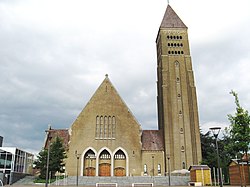Genk
| Genk | |||
|---|---|---|---|
| Municipality | |||

Church of Saint Martin
|
|||
|
|||
| Location in Belgium | |||
|
Location of Genk in Limburg
|
|||
| Coordinates: 50°58′N 05°30′E / 50.967°N 5.500°ECoordinates: 50°58′N 05°30′E / 50.967°N 5.500°E | |||
| Country | Belgium | ||
| Community | Flemish Community | ||
| Region | Flemish Region | ||
| Province | Limburg | ||
| Arrondissement | Hasselt | ||
| Government | |||
| • Mayor | Wim Dries (CD&V) | ||
| • Governing party/ies | CD&V | ||
| Area | |||
| • Total | 87.85 km2 (33.92 sq mi) | ||
| Population (1 January 2016) | |||
| • Total | 65,691 | ||
| • Density | 750/km2 (1,900/sq mi) | ||
| Postal codes | 3600 | ||
| Area codes | 089 | ||
| Website | www.genk.be | ||
Genk (Dutch pronunciation: [ɣɛŋk]) is a city and municipality located in the Belgian province of Limburg near Hasselt. The municipality only comprises the city of Genk itself. It is one of the most important industrial cities in Flanders, located on the Albert Canal, between Antwerp and Liège.
54% of the inhabitants are of foreign origin from about 85 different nationalities, mostly Italians, Turks, and Greeks.
Genk probably originated as a Celtic village, and was converted to Christianity in the 10th century. The remains of a little wooden church dating from that period were found in the area. The first mention of Genk as Geneche can be found in a document dating from 1108, ceding the territory to the Abbey of Rolduc. Politically, Genk belonged to the County of Loon until it was annexed by the Prince-Bishopric of Liège in 1365.
During a century of on-going industrialisation further south in Belgium, Limburg modernised only slowly: Genk remained unimportant and small, growing slowly to a population of 2,000 around 1900. The peaceful village was the home of landscape painters and writers such as Neel Doff.
In 1901, André Dumont found a large quantity of coal in the nearby village of As. Soon after, the "Black Gold" was also found in Genk. After World War I, the village started to attract a large quantity of both Belgian and foreign immigrants, and quickly became the biggest city in Limburg after Hasselt, peaking to a population of 70 000. However, in 1966 the coal mine of Zwartberg closed down, and Genk had to develop new industries, mainly along the Albert Canal and highways. By the end of the 1980s, the two remaining coal mines at Winterslag and Waterschei were also closed.
...
Wikipedia




